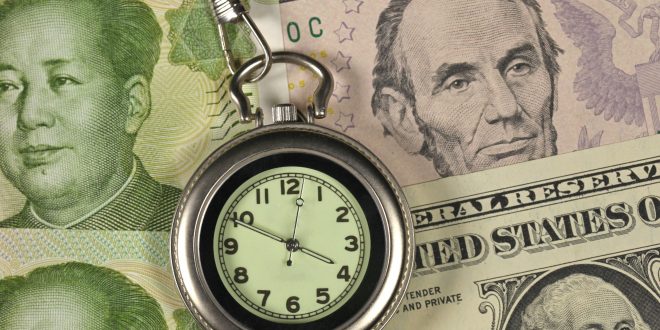Some negative factors pushed the US dollar lower at the end of the week, but the dollar managed to recover after better than expected US jobs data. The US Dollar Index, which measures the greenback’s strength against a basket of major currencies, ended the week flat at 92.78 versus 92.08 last week. The index fell to its lowest level during the week at 91.86 versus a peak at 92.82.
As for the British Pound, closed trading in a bearish direction, affected by the rise in the US Dollar after the better than expected jobs report. As a result, the sterling fell against the US dollar to 1.3974 versus 1.926.
Oil
Oil prices fell by about 1 percent on Friday, posting their most significant weekly losses in months amid fears that travel restrictions to limit the spread of the mutated delta variant of Covid-19 will undermine the global recovery in energy demand.
Oil futures were also under pressure as the dollar rose after the monthly growth of US jobs came in higher than expected. A stronger dollar makes priced oil more expensive for buyers of other currencies.
Brent crude futures closed down 59 cents, or 0.8% percent,, to $70.70, while US West Texas Intermediate crude futures fell 81 cents, or 1.2 percent, to settle at $68.28 a barrel.
On a weekly basis, global benchmark Brent crude shed more than 6%, its biggest weekly decline in four months, and West Texas Intermediate sank nearly 7%, its biggest weekly drop in nine months.
Japan is preparing to expand emergency restrictions to more areas, while China, the world’s second-largest oil consumer, imposed restrictions in some cities and canceled flights.
Gold
Gold fell on Friday, August 6, to stay near the critical level of $1800 an ounce. It came under pressure from the stronger dollar. US gold futures fell 0.4% to $1,802.50.
Here are the most important events and data for the past week:
Wall Street
The Dow and S&P 500 closed at record highs on Friday after a stronger-than-expected jobs report, while investors shrugged off concerns about the delta variant strain affecting the economic recovery.
A Labor Department report showed that non-farm payrolls increased by 943 thousand jobs last month. Economists polled by Reuters had expected a job increase of 870,000.
The closely watched Labor Department employment report showed substantial wage increases as the unemployment rate dropped to a 16-month low.
According to data, the Dow Jones Industrial Average rose 144.78 points, or 0.41 percent, to 35,209.03 points, and the Standard & Poor’s 500 closed up 7.49 points, or 0.17 percent, to 4436.59 points, while the Nasdaq Composite Index fell 59.36 points, or 0.4 percent, to 14,835.76 points.
Non-farm payroll
Data from the US Bureau of Labor Statistics on Friday showed that US jobs rose by 943K in July, and that reading followed June’s increase of 938K (revised from 850K) and beat expectations of 870K.
The report showed that the unemployment rate fell to 5.4% from 5.9% in June, and the labor force participation rate improved to 61.7%. Average hourly earnings rose 4% compared to market expectations of 3.8%.
Analysts point out that the better-than-expected July report is a step in the direction of “substantial further progress” that the Fed is looking forward to. About 75% of the jobs lost during the coronavirus shutdowns were restored in July, but there are still 5.7 million fewer jobs than in February. Analysts expect that the Delta variant will lead to a decline in labor force participation over the next few months.
U.S Weekly Initial Claims
There were 385,000 initial claims for unemployment benefits in the US during the week ending July 31, the data published by the US Department of Labor showed last week. This reading came after the previous reading of 399,000 (revised from 400,000) and slightly above the market expectation of 384,000.
BoE Rate decision
The Bank of England’s Monetary Policy Committee (MPC) decided to leave the benchmark interest rate unchanged at 0.10% following the August policy meeting. It kept the Asset Purchase Facility steady at £895 billion as widely expected.
Additional qoutes as summarized by Reuters
“8 MPC members voted to keep rates unchanged.”
“The committee’s central expectation is that current elevated global and domestic cost pressures will prove transitory.”
“Nonetheless, the economy is projected to experience a more pronounced period of above-target inflation in the near term than expected in the may report.”
“The economy is projected to have a margin of excess demand for a period.”
“In the medium term, conditioned on the market path for interest rates, inflation is projected to fall back to close to the 2% target.”
“The number of full and part-time furloughed jobs has continued to decline as demand has recovered but remained at around 2 million at the end of June.”
“There appear to have been difficulties in matching available jobs and workers.”
Australian Trade Balance
Australia’s balance of goods and services for June seasonally adjusted, released by the Australian Bureau of Statistics, has arrived as follows:
- Surplus A$+10,496M vs. Reuters poll: A$+10,450M
- Exports +4 pct m/m, seasonally adjusted.
- Imports +1 pct m/m, seasonally adjusted.
The Reserve Bank of Australia (RBA) board members left the official cash rate (OCR) at a record low of 0.10% at their August monetary policy meeting
German data showed that retail sales rose by 4.2% MoM, vs. 2.0% expected. On an annual basis, German retail sales came in 6.2% higher in June versus expectations for a 2.4% decline.
Eurozone’s Retail Sales rose by 1.5% MoM in June vs. 1.7% expected and 4.1% last, the official figures released by Eurostat showed last week.
On an annualized basis, the bloc’s Retail Sales increased by 5.0% in June vs. 8.6% in May and 4.5% expected.
Economic activity in the US manufacturing sector expanded in July, albeit at a slower pace than in June. The ISM’s Manufacturing PMI fell to 59.5 from 60.6, below expectations of 60.9.
The Prices Paid Index retreated to 85.7 from 91.2 in June. Likewise, the New Orders Index declined to 64.9 from 66.
ISM’s Services PMI rising to a new series-high of 64.1 from 60.1 in June. This reading came in better than the expectation of 60.4.
 Noor Trends News, Technical Analysis, Educational Tools and Recommendations
Noor Trends News, Technical Analysis, Educational Tools and Recommendations





